国际交流英语_图文
- 格式:pdf
- 大小:2.04 MB
- 文档页数:16



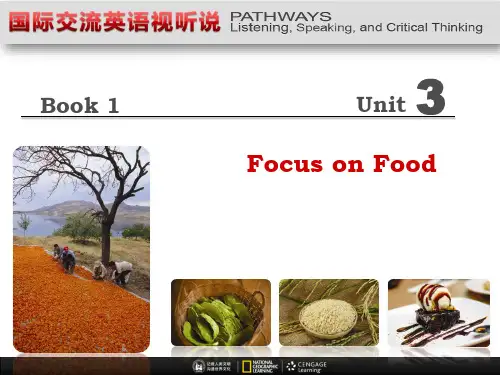
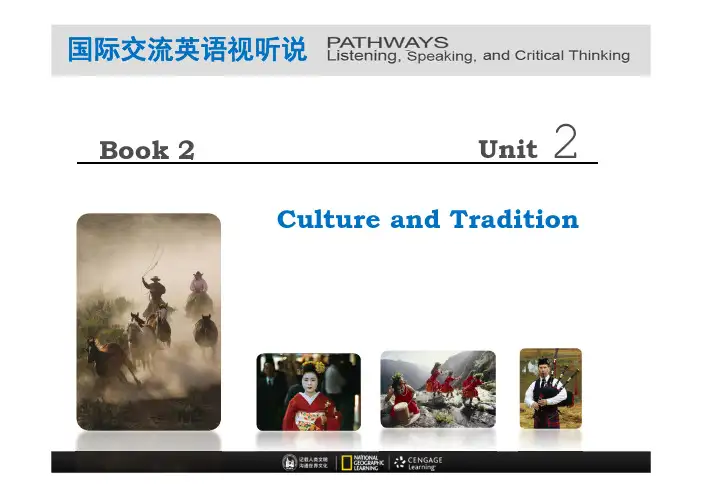
Unit 2Book 2 Culture and TraditionThink and Discuss Viewing the WorldExploring the ThemeAnalytical ListeningSharing Your IdeasEngagingFurther ListeningC ontentUnit 2 Culture and TraditionT hink and Discuss1.Look at the photo. What do youknow about cowboys?2.In which countries do cowboyslive and work?A cowboy and a cowgirlherding horses in Oregon,U.S.AQuestionsQuestions1.Look at the photo. What do you know about cowboys?Example AnswersI know that cowboys ride horses, and their job is to takecare of cows, or cattle. Many cowboys work on ranches,which are farms where cattle and other animals are raised.Questions2.In which countries do cowboys live and work?Example AnswersCowboys live and work in North and South America, from Canada and the U.S.A. to Mexico, Brazil, Argentina, etc.国际交流英语视听说Culture and TraditionUnit 2E xploring the ThemeCulture and Tradition Look at the photos and read the captions. Then discuss the questions.1.Where do these people live?2.How are these people similar?3.What are some cultures that interest you? Why?4.What are some things that make your own culture special?An Argentine gaucho, or cowboy, herdsblack cattle through a field.Culture and TraditionIn Japan, geishas are female entertainers. The wordgeisha means “art person”. Geishas spend a lot of time studying how to perform traditional Japanese music and dances.Culture and TraditionCulture and Tradition The Sherpa people live in Array the Himalayan region. Theword Sherpa means “easternpeople”. The word Sherpaniis used for female Sherpas.guides and help peopleclimb mountains,particularly MountQomolangma.The Roma people lived in India before they moved to Europe. Today,there are many Roma people living in Romania, Hungary, and otherEuropean countries. When Roma children go to a school where people speak a different language, they often stop speaking their Roma language. Scientists estimate that 3,000 languages might disappear in the next 100 years as people stop speaking their native languages.Culture and TraditionCulture and TraditionAborigines are the original people of Australia. There are many different groups of Aborigines living there. Each group has its own language, culture, and customs.In the United States, the Navajo Indians still do their traditional dances, and many speak both the Navajo language and English.Culture and TraditionGauchos are cowboys from Brazil, Argentina, and Uruguay. Gauchos’ work involves moving herds of cattle from one place to another.Culture and TraditionCulture and Traditiongeisha: a woman who works as a traditional Japanese entertainer. Geishas are trained in traditional Japanese arts including singing, dancing, as well as conversation and games. 日本艺妓Culture and TraditionSherpa: a member of an ethnic group living in the Himalayan region. The Sherpas are best-known for their work as expert mountaineers and porters (行李搬运工) who take expeditionsup the mountains in the Himalayas. 夏尔巴人gypsy:a name used to describe a member of the Roma ethnic group. The name comes from a mistaken historical belief that they were Egyptian in origin. The Roma have several different languages and cultures. Most Roma live in Europe, though there are Roma populations in North and South America. 吉卜赛人Culture and TraditionAborigine:a name used to describe people who are historically native to a region. The best-known example is the people who lived in Australia before European settlers arrived. The term “indigenous person” has the same meaning and is usually considered more acceptable. 澳大利亚土著居民Culture and TraditionNavajo Indian: a member of a tribe of native American Indians in the U.S.A. Many Navajo live in the Navajo Reservation ( 纳瓦霍印第安人居留地) which occupies parts of the states of Arizona, New Mexico, and Utah. The Navajo people are famous for their traditional arts and crafts, including weaving and silver jewelry. 纳瓦霍印第安人Culture and Traditiongaucho:a person who rides a horse and works with cattle in parts of South America. Gauchos are famous for their rugged ( 吃苦耐劳的) and independent lifestyle. 加乌乔牧人Culture and TraditionCulture and Tradition 1.Where do these people live?Example AnswersGeishas live in Japan.The Sherpa people live in the Himalayan region.The Roma people live in Romania, Hungary, and other European countries.Aborigines live in Australia.The Navajo Indians live in the United States.Gauchos live in Brazil, Argentina, and Uruguay.Culture and Tradition 2. How are these people similar?Example AnswersThese people represent old cultural traditions in the placeswhere they live. They also represent smaller culturalgroups—not huge populations.Culture and Tradition 3. What are some cultures that interest you? Why?Example Answers• I’m interested in the Hawaiian culture because I think huladancing is beautiful and the Hawaiian Islands are verybeautiful.• I’m interested in the Sami people of Scandinavia because they herd reindeer, their culture and language are very old,and their customs are disappearing quickly.• I’m interested in the culture of Sri Lanka because it has been influenced by several ethnic groups, including theSinhalese (僧伽罗人), Tamil (泰米尔人), etc.Culture and Tradition 4. What are some things that make your own culture special?Example AnswersMy own culture, Chinese culture, is special because it is soancient. Its history goes back thousands of years. Chineseculture is also special because China covers such a largegeographical area, and Chinese food, customs, andlanguages have traveled to many places, includingSingapore, Indonesia, and Malaysia, to name a few.国际交流英语视听说A nalytical ListeningUnit 2Culture and TraditionRobb Kendrick 罗布·肯德里克(人名)Tyrel Tucker 蒂雷尔· 塔克(人名)ranch n. 大牧场Wyoming 怀俄明州(美国西部州)Manuel Rodriguez 曼努埃尔·罗德里格斯(人名)Coahuila 科阿韦拉州(墨西哥东北部州)La Mora Ranch 拉莫拉农场Listening 1Listening 1vaquero: a Spanish word used to describe a man who rides a horse and works with cattle. The vaquero style of working with cattle came historically from Spain to Mexico and spread to California, New Mexico, and Texas in the U.S.A. 牧牛人charro: a kind of traditional cowboy from Mexico. Thecharros are best-known for their colorful hats and clothes, and for their traditional Mexican rodeos (牛仔竞技表演), called charreadas . 墨西哥牛仔Listening 1Prior Knowledge. Discuss the questions with a partner.Before Listening Listening 11.What do you know about cowboys’ lifestyle?2.Besides North America, do you know of any other regions that have cowboys? What arethey called in those places?Cowboy still work onranches in the westernUnited StatesListening 11.What do you know about cowboys’ lifestyle?Example AnswersThe lifestyles of cowboys involve being away from home for long periods, riding horses, and living and working with cattle outdoors.Listening 12. Besides North America, do you know of any other regions that have cowboys? What are they called in those places?Example AnswersBesides North America, there are cowboys called gauchos who live in Argentina, Brazil, and Uruguay. Other cowboys called paniolos live in Hawaii, and vaqueros live in Mexico.A |Listening for Main Ideas.Listen to the first part of the lecture and check(√) the main idea you hear.A LectureListening Listening 1☐The last cowboys disappeared a long time ago.☐Fewer young people want to be cowboys because of the money matters.☐In some parts of the world, there are still traditionalcowboy customs.√Listening 1Professor Daley: OK, so let’s continue. A lot of people today think that the last cowboys disappeared a long time ago. It’s true that there are fewer cowboys today, and the cowboy way of life is endangered. Money is a big factor here. Cowboys usually don’t make a lot of money for all the hard work they do, so fewer young people today want to be cowboys—it’s not an easy lifestyle. Even so, in some parts of the world, cowboys still ride their horses, watch the cattle, and practice traditional cowboy customs.B | Listening for Details.Listen to the entire lecture and complete the notes about the two cowboys.Listening 1•________ years old when the photo was taken•got his first horse when he was_________________•one winter, he worked alone with his_______________ on a ranch •took care of _________ cattle •lived in a shack with no ___________•_____________ the work Tyrel Tucker18two years old older brother2,300electricity enjoyedListening 1 •started working with his father whenhe was _______________•_________ generations of his familyhave worked on the same ranch•got ____________ and moved to thecity•wants to ______________ to thecountryside and work as a vaquero again Manuel RodriguezB| Listening for Details.Listen to the entire lecture and complete the notes about the two cowboys.four years oldfourmarriedmove backC| Making Inferences. Read the statements. Then listen again and check (√) T for true or F for false. The statements are not in the professor’s exact words. You need to think about what you hear.Listening 11. Tyrel liked school.2. Tyrel and his brother ate a healthy diet.3. Both Tyrel and Manuel would be very unhappy living in a big city.4. The two men want to get better jobs.T F ☐☐☐☐☐☐☐☐Listening 1Example Answers1. F (He was happy to leave school at the age of 17.)2. F (They ate the same few foods every day, and didn’t eatvegetables or fruits.)3. T4. F (Tyrel enjoys cowboy work, and Manuel plans to work as acowboy again after his first child is born.)Listening 1D| Discussion. Read the questions. Then listen again and discuss the questions with your partner.1. When did the cowboy tradition start in Mexico? Why?2. Who did the Mexican vaqueros used to work for?3. What did the Mexican vaqueros wear? For whatreasons did they wear those clothes?4. Which part of America did the Mexican cowboys firstmoved into?5. How many kinds of cowboys are there in Mexico today?What are they?Listening 11.When did the cowboy tradition start in Mexico? Why?Example AnswersThe cowboy tradition in Mexico started in the 1600sbecause Spanish people brought cattle to the NewWorld. Workers are needed to take care of the cattle.Listening 1 2. Who did the Mexican vaqueros used to work for?Example AnswersThe Mexican vaqueros used to work for people whoowned big ranches.Listening 13. What did the Mexican vaqueros used to work for?Example AnswersThe Mexican vaqueros used to wear big hats to keep the sun off their faces and high boots to protect their legs.Listening 1 4. Which part of America did the Mexican cowboys firstmoved into?Example AnswersThe Mexican cowboys first moved into Texas in the southern U.S.A.Listening 15. How many kinds of cowboys are there in Mexico today?What are they?Example AnswersThere are two kinds of cowboys in Mexico today. Onekind, called charros, ride horses and compete in sports.The other kind, called vaqueros, work with cattle on the ranches.Critical Thinking.Form a group with two or three other students. Discuss the questions.Listening 1After Listening 1. Why do you think Robb Kendrick used an old kind of camera for his pictures?2. What kinds of people want to be cowboys now?3. Why do you think they like the cowboy’s way of life?4. Would you like this way of life? Why or why not?5. Are there cowboys in China? If yes, what is their way of life like?Listening 11. Why do you think Robb Kendrick used an old kind of camera for his pictures?Example AnswersRob Kendrick used an old camera probably becausecowboy work is an old tradition, and Kendrick wantedthe photos to look old-fashioned, not modern.Listening 1 2. What kinds of people want to be cowboys now?Example AnswersPeople who want to be cowboys now probably likeanimals and enjoy working outdoors, and they don’t expect to make a lot of money or live in luxury.Listening 1 3. Why do you think they like the cowboy’s way of life?Example AnswersThey probably like the cowboy’s way of life because they have a love for freedom.Listening 1 4. Would you like this way of life? Why or why not?Example Answer 1Yes, because I’d like to seek a life of loneliness in the wild nature. I also like freedom and enjoy workingoutdoors, so the cowboy lifestyle would work for me.Listening 14. Would you like this way of life? Why or why not?Example Answer 1No, because it’s important to me to earn enough money to save and invest. I need to live with my family, so the cowboy lifestyle wouldn’t work for me.。
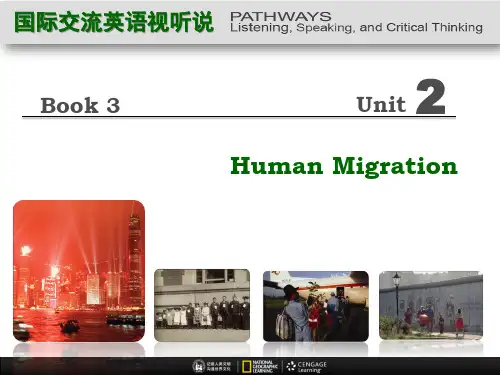
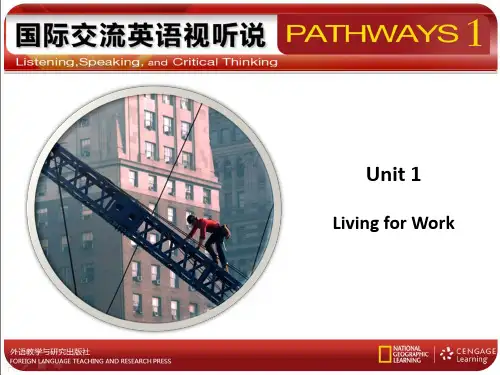

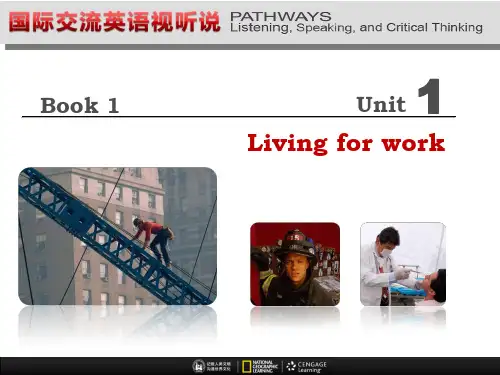

30sGood afternoon, everyone. The title of the paper is Visible Microspectroscopy for Diagnosis of Gastric Precancer. Its author is Liu Yong from Department of Physics, Zhao qing University. It’s presented by Li Mengfan from CAS, Hefei Institutes of Physical Science. You can know more about cancer and the new method to diagnose gastric precancer after reading this paper.58sCancer is very common among human beings. It is mostly related to the habit of the patients, the job, the environment, the drinking water and the soil matters, too. If a person is affected by certain bacteria, he may also get gastric cancer. Bad habits like smoking, drinking, mental tension, eating improperly and living irregularly increase the possibility of having cancer. Before specific treatment, the doctor should make sure whether the patient has cancer and where the focus is. The method used to diagnose cancer and locate thecancerous area is very important.42sBefore we design a method to diagnose cancer, we should know more about cancer like where it starts and what it causes.Firstly, about 90% of the human’s cancer start from the epithelial layer of skin, internal organs and tubular organs in the body. Secondly ,cancer usually accompanied by the changes of organization structure in the cell level.So, the changes which appear in the structure of organization and chemical composition provides important evidence for diagnosis of precancer.42sNormal method to diagnose gastric precancer is Reflectance spectroscopy. It’s very prospective in early diagnosis of cancer and is commonly used these years.One of the most common technology is diffuse reflectance visible spectroscopy, it can acquire the approximate information of the target tissue. This method is low cost, fast and non-invasive, it provides important means for diagnosis of malignant damage of organization of human organs. However, there are also some disadvantages of this method which need to be improved.55sThis is the system of diffuse reflectance spectroscopy, the light beam emitted from the tungsten halogen lamp is guided into the integral ball by the source fiber. The light come out of the integral ball irradiate the standard board, the reflected light of the standard board is treated as the background. Then take target tissue substitute for the standard board, and scan the reflected light of it. The reflected light spectra of the gastric tissue mucosal layer and the submucosa layer is guided into the spectrometer by the collector fiber. The spectrometer and the computer is connected by USB, spectrum can be processed using computer.36sFirst of all, only average visible spectrum of the target tissue can be acquired, it means that the docters cannot make out the location of the cancerous tissue precisely.What’s more, the device is easy to be affected by changes of optical path length induced by different set-up of prober and the variation of hemoglobin concentration due to the pressure between prober and tissue.50sTo avoid the problems of the commonly used techniques, diffuse reflectance visible spectroscopy, scientists do a lot of researches to find out a new way to diagnose precancer.The new method is Visible Microspectroscopy. The visible microspectroscopic measurement device is accomplished on the basis of fiber confocal microscope, its 3-d imaging principle devote to the optical tomography ability of the system.The visible microspectrum of cancerous and normal tissue can be analysed andcontrasted, so it’s more useful than the normal method.45sThis is the structure of the visible microspectroscopy device .The fiber coupler can separate the lighting beams from the signal beam. The two lens can focus the light on the tissue ,The 3-D electronic controlled platform move along the direction of optic axis, so that the device can acquire the visible microspectroscopy signal of the sample in different depth, precisely locate the boundary of the cancerous tissue.The signal measured from different position can be stored in the computer after analysed by the spectrometer.31sThis is the spectrum chart of the normal tissue and cancerous tissue, they are analyzed by the spectrometer before being transmitted to the computer. The upper chart is the visible spectrum of normal tissue, it is regular. Contrasting to this, in the nether chart, the spectrum of the cancerous area shows that the strength of reflected light grows as the wave length grows.49sIn comparison with the normal method, there are a lot of advantages of the new method.Firstly, the structure of visible microspectroscopy device is very simple. The main parts consist of source, fiber coupler, 3-D electronic controlled platform, spectrometer and the computer.Secondly, the 3-D space microspectrum can be acquired , which can help the doctors efficiently make out whether the gastric tissue is cancerous.What’s more, the optical tomography ability enabled the device to precisely locate the edge of the cancerous area.32si.In conclusion, the main goal of this research is to find a new way to diagnose thegastric precancer.ii.The spectrum of the normal and cancerous gastric tissues which can be measured by visible microspectroscopy in cell level is the central idea .iii.This new method can obtain the cell level information, and is not affected bychanges of optical path length and hemoglobin concentration.50si. The device is very simple, so it can have a small size, which can reduce the sufferings of patients.It can efficiently make out whether the tissue is canceration.ii. Besides, the 3-D space microspectrum and optical tomography ability can make the device accurately distinguish the cancerous tumor area from the normal tissue in cell level, thus the boundary of the cancerous tissue can be ascertained accurately.iii. The result of the research shows that this device may be used to non-invasively diagnosis of early gastric cancer.20sThis device is only researched in the lab, there are still a lot of works to do to make this device applied into practice. So, s pecial design of this device should be made which can be applied to the medical diagnosis.给大家推荐一个英语微信群Empty Your Cup英语微信群是目前学习英语最有效的方法,群里都是说英语,没有半个中文,而且规则非常严格,是一个超级不错的英语学习环境,群里有好多英语超好的超牛逼的人,还有鬼佬和外国美眉。
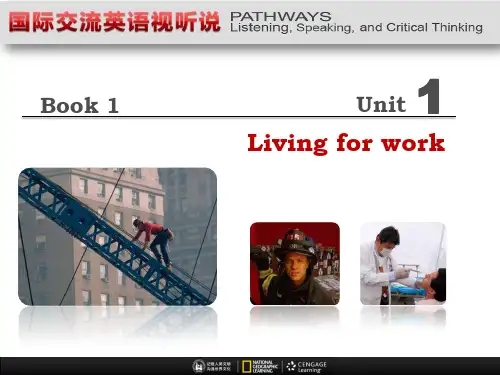
∙headaches, pains, and allergies∙insomnia or sleeping too much∙feelings of anger, depression, vulnerability∙idealizing your own culture∙trying too hard to adapt by becoming obsessed with the new culture ∙the smallest problems seem overwhelming∙feeling shy or insecure∙become obsessed with cleanliness∙overwhelming sense of homesickness∙feeling lost or confused∙questioning your decision to move to this place(Ⅲ)五个阶段1、honeymoon period2、Culture chock3、Initial adjustment4、Depression time5、Acceptance & integrationThe Culture Shock Model(参考)Step 1: The Honeymoon Stage Like any new experience, there's a feeling of euphoria when you first arrive to a new country and you're in awe of the differences you see and experience. You feel excited, stimulated, enriched. During this stage, you still feel close to everything familiar back home.Step 2: The Culture chock StageEverything you're experiencing no longer feels new; in fact, it's starting to feel like a thick wall that's preventing you from experiencing things. You feel confused, alone and realize that the familiar support systems are not easily accessible.Step 3: Depression StageDuring this stage, you start refusing to accept the differences you encounter. You're angry, frustrated and even feel hostile to those around you. You start to idealize life "back home" and compare your current culture to what is familiar. You dislike the culture, the language, the food. You reject it as inferior. You may even develop some prejudices towards the new culture. Don't worry. This is absolutely normal. You're adjusting. This is actually a pretty common reaction to anything new. Think back to when you started a new job or moved to a new house or a new city or when you moved in with someone. Any adjustment can cause you to look back in awe and wonder why you made the decision to change.Step 4: Initial adjustment StageThis is the first stage in acceptance. I like to think of it as the emergence stage when you start to rise above the clouds and finally begin to feel like yourself again. You start to accept the differences and feel like you can begin to live with them. You feel more confident and better able to copewith any problems that may arise. You no longer feel isolated and instead you're able to look at the world around you and appreciate where you are.Step 5: Independence(Acceptance & integration)StageYou are yourself again! You embrace the new culture and see everything in a new, yet realistic light. You feel comfortable, confident, able to make decisions based on your own preferences. You no longer feel alone and isolated. You appreciate both the differences and similarities of your new culture. You start to feel at home.While being transferred into a different environment puts special pressure on communication skills, there are practical difficulties to overcome, such as circadian rhythm disruption that often leads to insomnia and daylight drowsiness; adaptation of gut flora to different bacteria levels and concentrations in food and water; difficulty in seeking treatment for illness, as medicines may have different names from the native country's and the same active ingredients might be hard to recognize.Still, the most important change in the period is communication: People adjusting to a new culture often feel lonely and homesick because they are not yet used to the new environment and meet people with whom they are not familiar every day. The language barrier may become a major obstacle in creating new relationships: special attention must be paid to one's and others' culture-specific body language signs, linguistic faux pas, conversation tone, linguistic nuances and customs, and false friends.In the case of students studying abroad, some develop additional symptoms of loneliness that ultimately affect their lifestyles as a whole. Due to the strain of living in a different country without parental support, international students often feel anxious and feel more pressure while adjusting to new cultures—even more so when the cultural distances are wide, as patterns of logic and speech are different and a special emphasis is put on rhetoric.Adjustment phase[edit]Again, after some time (usually 6 to 12 months), one grows accustomed to the new culture and develops routines. One knows what to expect in most situations and the host countrySome people manage to adapt to the aspects of the host culture they see as positive, while keeping some of their own and creating their unique blend. They have no major problems returning home or relocating elsewhere. This group can be thought to be somewhat cosmopolitan.给大家推荐一个英语微信群Empty Your Cup英语微信群是目前学习英语最有效的方法,群里都是说英语,没有半个中文,而且规则非常严格,是一个超级不错的英语学习环境,群里有好多英语超好的超牛逼的人,还有鬼佬和外国美眉。